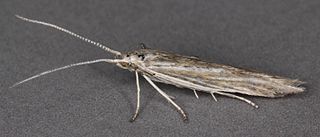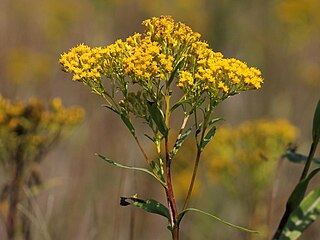
Solidago, commonly called goldenrods, is a genus of about 100 to 120 species of flowering plants in the aster family, Asteraceae. Most are herbaceous perennial species found in open areas such as meadows, prairies, and savannas. They are mostly native to North America, including Mexico; a few species are native to South America and Eurasia. Some American species have also been introduced into Europe and other parts of the world.

The Pterophoridae or plume moths are a family of Lepidoptera with unusually modified wings. Though they belong to the Apoditrysia like the larger moths and the butterflies, unlike these they are tiny and were formerly included among the assemblage called "microlepidoptera".

Stenoptilia bipunctidactyla, also known at the twin-spot plume is a moth of the Pterophoroidea family found in North Africa, Asia and Europe. It was first described by the Austrian physician and naturalist, Giovanni Antonio Scopoli in 1763. It is one of four similar looking moths.

Schinia nundina, the goldenrod flower moth, is a moth of the family Noctuidae. The species was first described by Dru Drury in 1773. It is found in North America from Minnesota to southern Ontario and Nova Scotia, south to central Florida and southern Texas. Records include Arizona, Kansas, Nebraska, New York, Maryland, Oklahoma and South Carolina.

Palthis angulalis, the dark-spotted palthis, is a moth of the family Erebidae. The species was first described by Jacob Hübner in 1796. It is found from Newfoundland west to coastal British Columbia, south to Florida and Texas.

Hellinsia osteodactyla is a moth of the family Pterophoridae. It is found in most of Europe, as well as North Africa and from Asia Minor to Japan. Also known as the small golden-rod plume it was first described by Philipp Christoph Zeller in 1841.

Hellinsia tephradactyla is a moth of the family Pterophoridae found in most of Europe. It was first described by the German taxonomist Jacob Hübner in 1813.

Hellinsia is a genus of moths in the family Pterophoridae.

Hellinsia lienigianus is a moth of the family Pterophoridae which inhabits coastal areas, dry pastures and waste ground and is found in Africa, Asia, Australia and Europe. Also known as the mugwort plume it was first described by Philipp Christoph Zeller in 1852.

Crombrugghia distans, also known as the Breckland plume is a moth of the family Pterophoridae found in Africa, Asia and Europe. It was first described by Philipp Christoph Zeller in 1847.
Crombrugghia laetus, also known as the scarce light plume is a moth of the family Pterophoridae, found in southern Europe, North Africa, the Canary Islands, Asia Minor and Iraq. It was first described by Philipp Christoph Zeller in 1847.

Platyptilia calodactyla is a moth of the family Pterophoridae found in Asia and Europe. It was first described by the Austrian entomologists, Michael Denis & Ignaz Schiffermüller in 1775.

Hellinsia carphodactyla is a moth of the family Pterophoridae, first described by Jacob Hübner in 1813. It is known from most of Europe, Asia Minor and North Africa.

Coleophora virgaureae is a moth of the family Coleophoridae. It is found from most of Europe through the Caucasus, Kazakhstan and Siberia eastward to the Baikal area and the Altai in Russia and Japan.

Hellinsia pectodactylus is a moth of the family Pterophoridae. It is found in Europe, the Canary Islands, Kyrgyzstan, Afghanistan, India and North America.
Hellinsia lacteodactylus is a moth of the family Pterophoridae described by Vactor Tousey Chambers in 1873. It is found in North America, including Florida, Mississippi, Kentucky, North Carolina, Colorado, Nova Scotia and British Columbia.

Hellinsia paleaceus is a moth of the family Pterophoridae described by Philipp Christoph Zeller in 1873. It is found in North America, including Florida, Mississippi Maryland, Montana, Texas, California, Nebraska, New Mexico and south-eastern Canada. It has also been recorded from Puerto Rico.
Hellinsia chlorias, the chlorias plume moth, is a moth of the family Pterophoridae. It is found in the United States, including Mississippi, New York, Colorado and Kentucky.

Solidago sect. Ptarmicoidei is a section of flowering plants in the genus Solidago. They are sometimes considered a separate genus: Oligoneuron. Like related species they are known as goldenrods. This section contains seven species of perennial herbs, all native to North America. They are distinguished from other goldenrods by their corymbiform flowerheads, which are flat or rounded in profile and about as broad as tall or broader, for which they are sometimes called flat-topped goldenrods.















